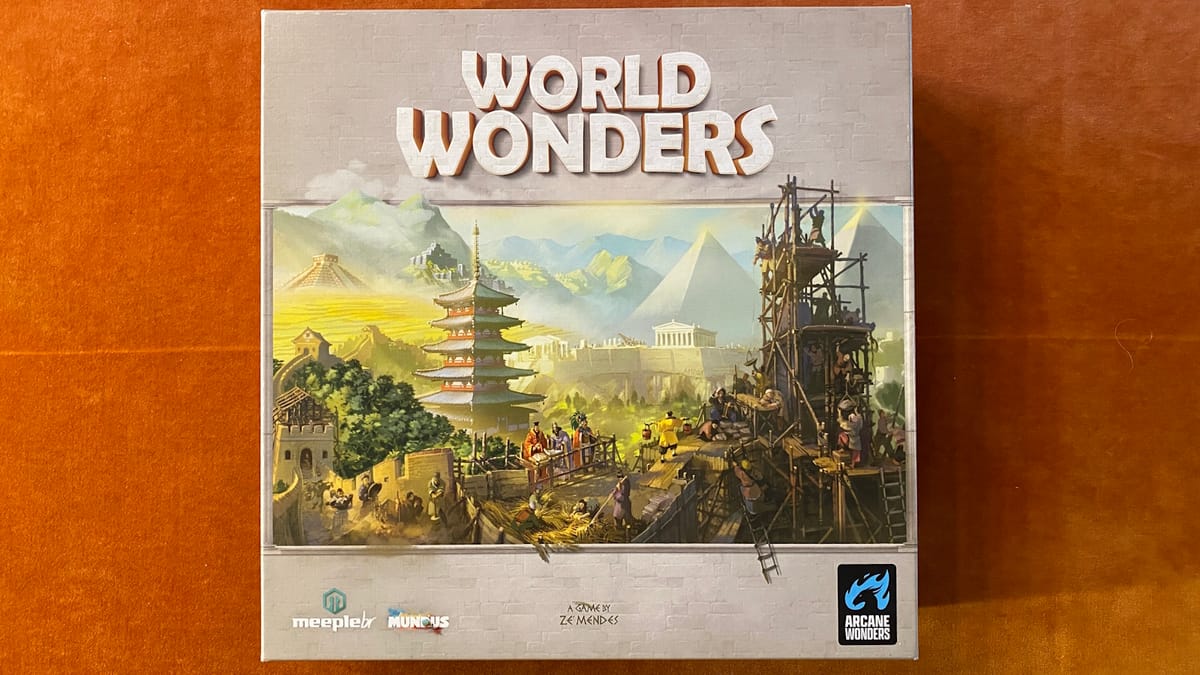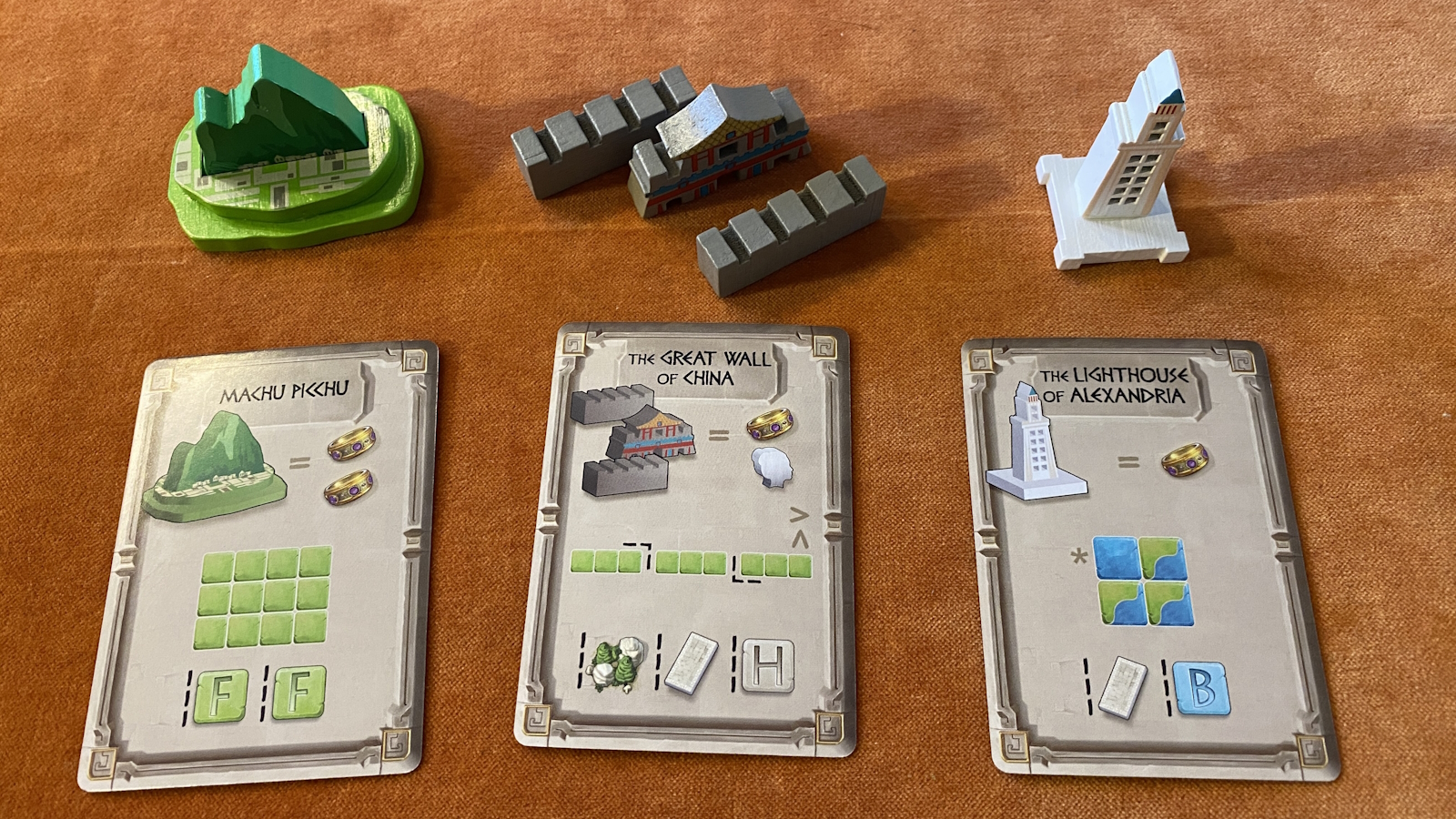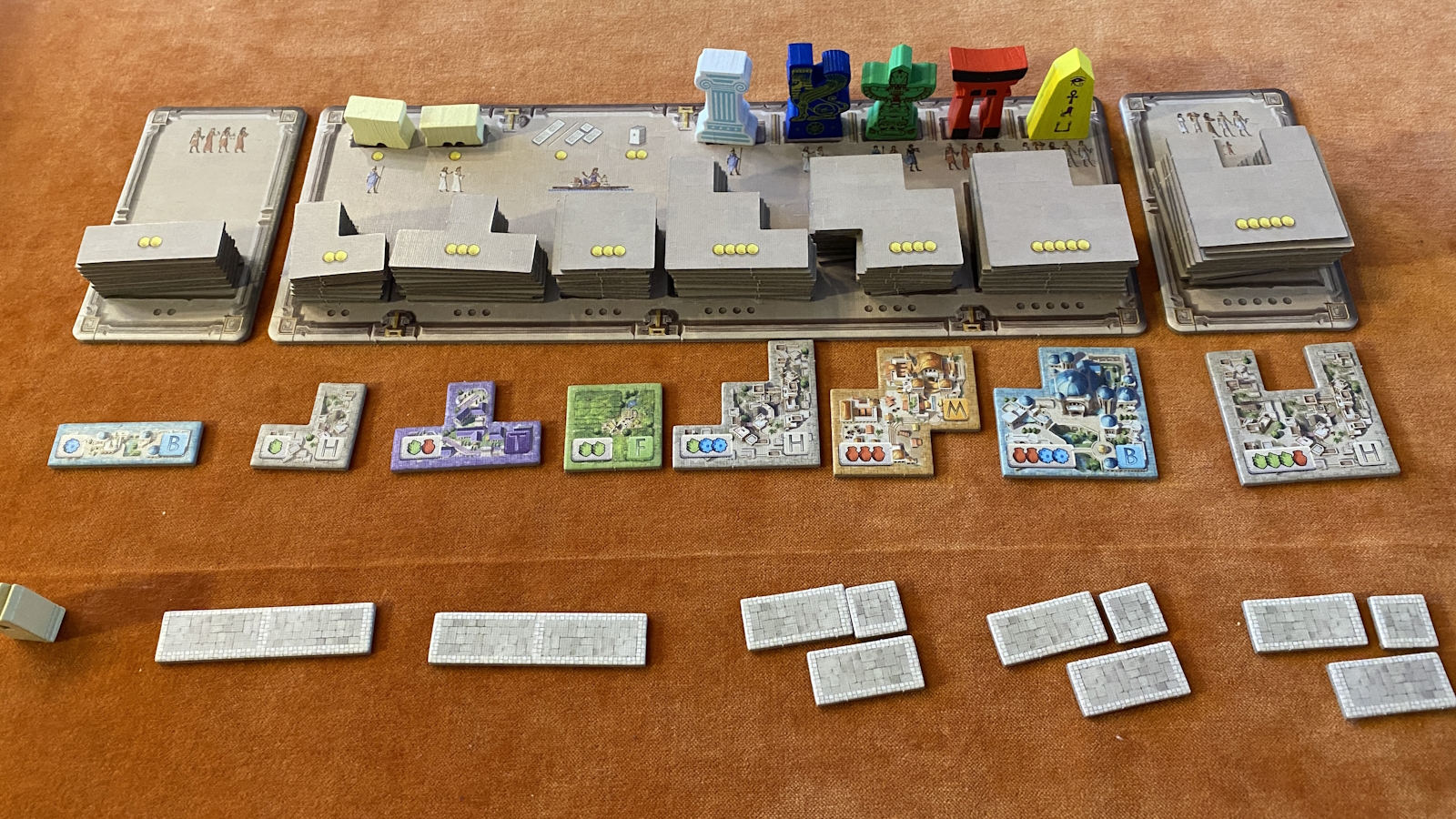
I enjoy heavy games. For example, I love to play A Feast For Odin, another tetromino placement game. World Wonders is not heavy, and yet it has some economic and logistic features that make it very enjoyable for its weight.
In World Wonders you’ll be spending your limited resources to buy building tiles and monuments to place on your personal board. You’ll need to carefully manage your road network in an effort to place tiles as efficiently as possible and earn the most points.

An example city after a few rounds.
Components
The rules are simple and straightforward. The mechanics aren’t very complicated and I had no problems learning how to play from the rulebook. Most of the rules can be easily explained and understood from the cheat sheets. There is even some historical information for each of the monuments included in the game.
The monuments are obviously supposed to be the centerpiece for this game. They are nicely crafted and painted wooden pieces. There is some occasional sloppy gluing, but not enough to bother me. The pieces look nice when spread out across your sprawling city.
The cards are good quality and shuffle easily. All of the cardboard tokens and boards are thick and functional. Each of the player turn order pieces are unique and painted as well. The overall component quality of the game is very high.

All of the monuments available for construction.
Gameplay
Like most tile placement games, you want to fill your board as efficiently as possible. However, World Wonders is less about tile synergy and is more about careful placement and future planning. The aspect that really makes the game interesting is road placement. Buildings generally must be placed next to roads and roads must be placed next to each other or one edge of the player board. You want to try and get your roads as deep as possible, but it is easy to end up blocking them off. There is a way to start a new road beyond your buildings by constructing a tower, but that is pretty expensive and only one is available per round for any player to purchase. Buildings can also be built away from a road as long as they are adjacent to another building of the same color.
Another great aspect of World Wonders is the economy. Everyone has seven coins to spend each round, although you can take a loan to get a few extra. Different actions cost a different amount of coins. Building a monument costs all of your remaining coins, so you ideally would like to make sure you only have a single coin left before purchasing one. It is first come first serve, though, so sometimes you’ll have to spend more for one you really want.

Three monuments are available at a time and each has its own requirements.
Buildings cost a different amount of coins depending on their size. The bigger buildings are more point efficient, but the smaller ones can more easily fit into tight areas. You earn points for every building you completely surround, so you want your city to be as tightly packed as possible. There are also natural resources spread around the map that will give you points if you reach them.
And while you’re doing all of that city planning, you want to keep an eye out for monuments to purchase. They’re all worth at least one point, so buying one for a single coin is a great value. They all have their own unique requirements for placement, usually wanting to be next to specific buildings along with roads or rivers, so you’ll need to keep that in mind. Some can also be very large, requiring you to take space into consideration.
For variety, there are two player boards available. There is a side with a lake that is the same for all players, and a side with varyingly shaped rivers. There is also a side A and B for the resource tracks, but they only have a minor impact on the game. If you play with the same players multiple times you can add in advanced scoring cards which let players compete for some extra points through unique objectives.

Solo and advanced play use additional decks.
Player Scaling
The best player count for World Wonders seems to be “as many as possible.” You can play solo with an automa controlled by a deck of cards, but it doesn’t have the same feel as a multiplayer game. A purchase option normally available to players is to buy first or second place in turn order for the following round. This can matter a lot as there are limited purchase options each round. The solo mode completely removes this and always has the player go second. The automa basically just randomly removes options for the player as they build up their city.
Two players is slightly better, but with six buildings available for the players to choose from, the turn order rarely plays a part in the game. There just isn’t enough interaction between the players at this count to be very interesting. In addition, at lower player count there is the possibility that the revealed monuments cannot actually be purchased with the buildings available. While I didn’t find this to be a problem, one of the other players complained about it.
Three to five players is where the game starts to become really interesting. Competition for tiles becomes fierce, so going early can be really important. Multiple people might want the same monument, so you have to consider if you want to make multiple small purchases or perhaps one large purchase and then straight to a monument. Since the monuments are refilled as soon as they are built, you might actually want to stall and hope for a replacement that works better for your city.
One negative with large player counts, however, is that sometimes you can run out of monuments half way through the game. While this doesn’t make the game fall apart mechanically, it does seem weird to be playing half of a game about World Wonders and not having any available to build.

With four or five players, more building shapes will be added to the game.
Conclusion
A fairly easy game to teach and play. I’d recommend World Wonders to both casual players and hardcore competitive players. The pieces are nice to play with and managing your economy while building your city as efficiently as possible is fun. This is a good game for getting some meaty decision making in while only taking around 90 minutes to play.
World Wonders
Great
A good medium weight tile placement game that plays best with three to five players.
Pros
- Excellent components.
- Fairly deep gameplay for a lighter weight and shorter play time.
Cons
- Lower player counts are less interesting.
- Might run out of monuments at higher player counts.